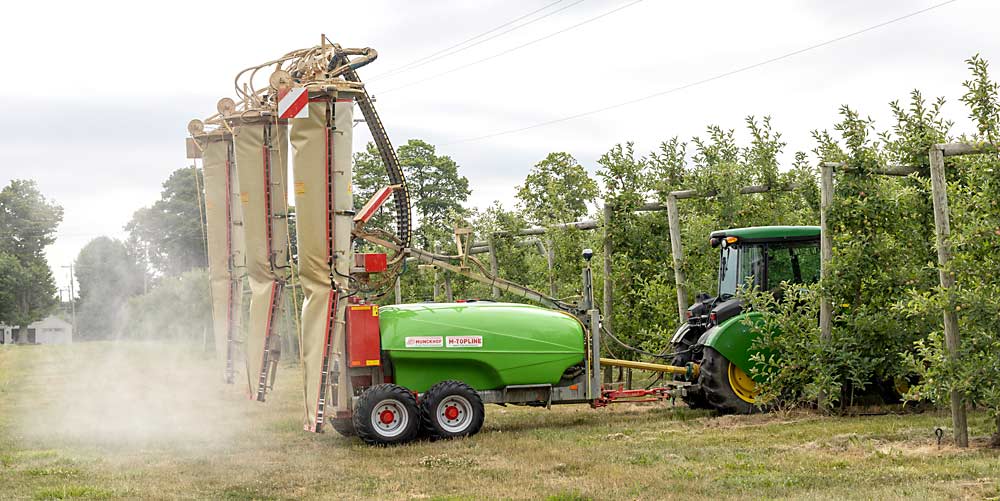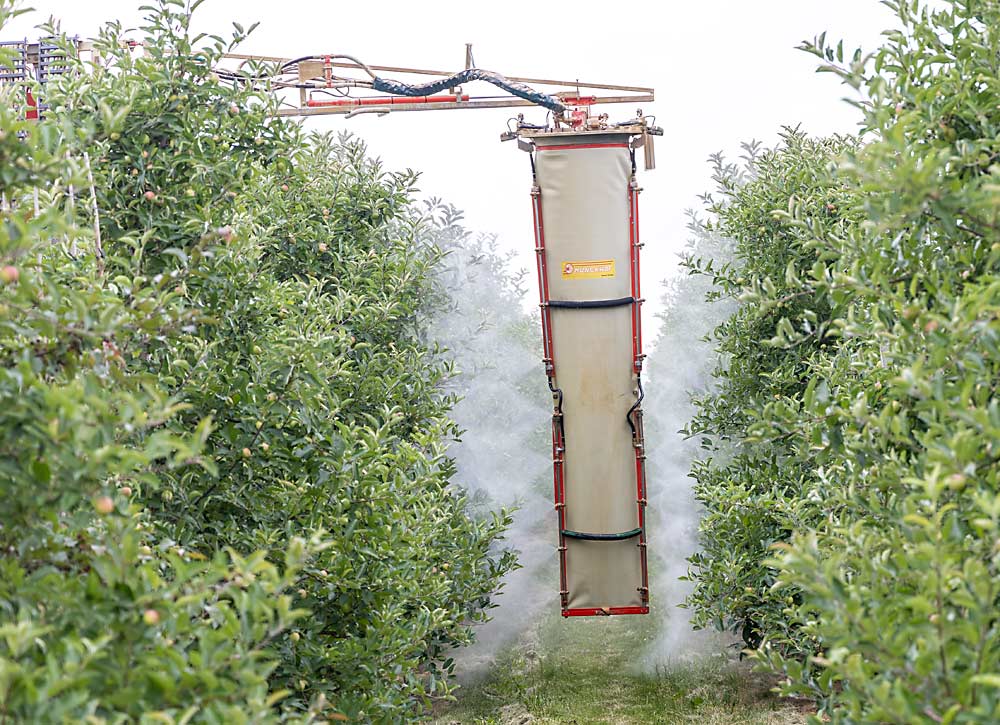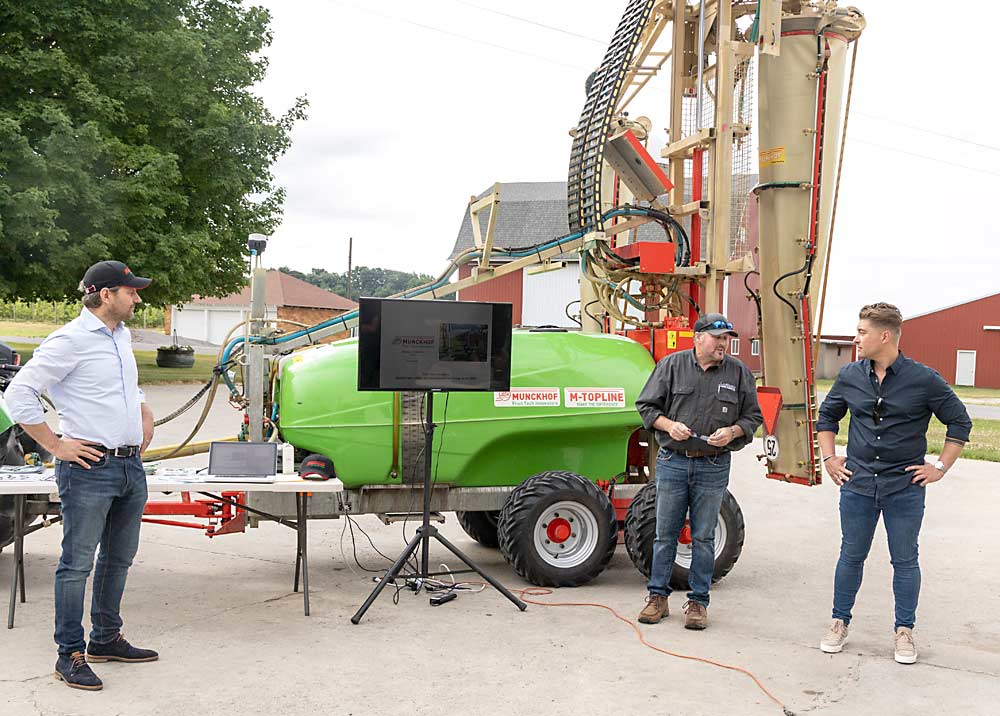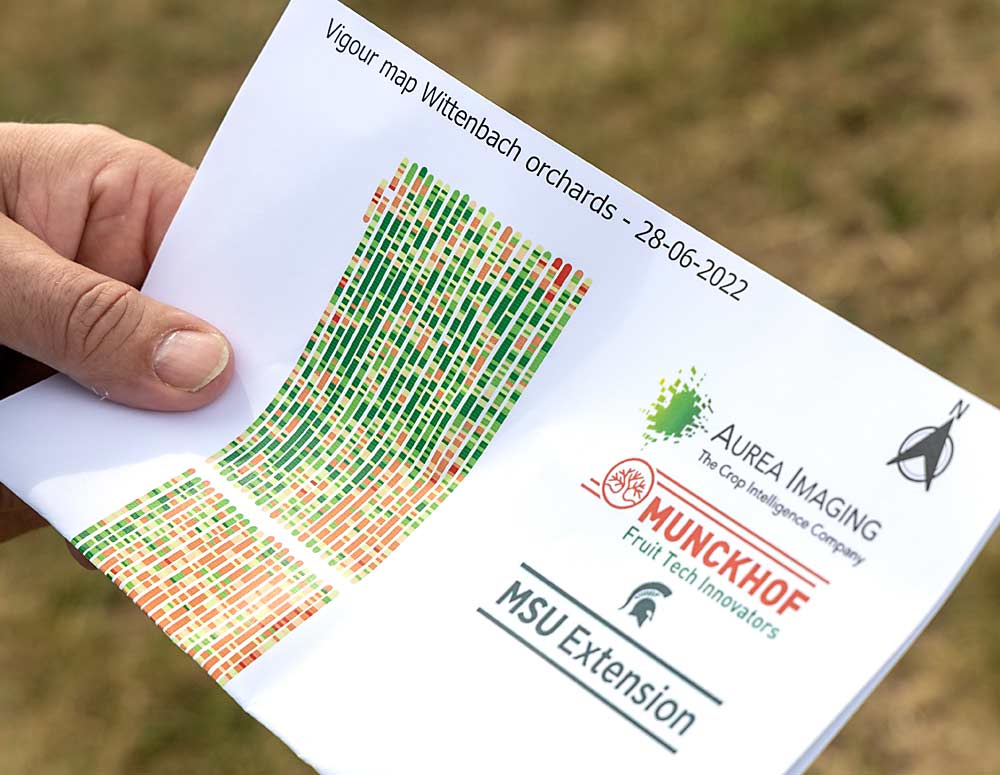
When it comes to precision orchard management, a team approach can do wonders.
New sensors are capable of collecting all kinds of data, but growers need ways to turn that insight into management. Uploading maps made from drone imagery to guide precision sprayer technology can make both tools more valuable.
Two Dutch companies have partnered to offer growers just that technology. The combination of Aurea Imaging’s digital mapping technology and Munckhof Fruit Tech Innovators’ modern sprayers has resulted in greater orchard uniformity and yield increases ranging from 12 percent to 65 percent in Dutch apple orchards, said Han Smits, Munckhof’s director of operations.
Hoping to find similar success in North America, the companies demonstrated the benefits of their combined technologies at Wittenbach Orchards in Belding, Michigan, in July. After a couple of presentations, grower Mike Wittenbach’s Munckhof three-row sprayer was pulled down a Gala block by tractor, spraying water on trees to demonstrate the accuracy of the technology.

A combination of drone footage, data analysis and automatic orchard sprayers can be used to apply blossom thinners, plant growth regulators or pesticides at the individual tree level. Growers often spray an entire block to deal with a problem, but that results in a waste of material because the pests, overabundant blossoms or high-vigor trees they want to target may only be concentrated in certain areas. Drone-generated digital maps can guide highly accurate sprayers to deposit the correct spray material exactly where the grower wants it — and leave the rest of the block alone, Smits said.
For blossom thinning, Aurea Imaging uses artificial intelligence technology to process drone images and turn them into a blossom map, where every tree has a specific value, said Aurea sales engineer Jasper Snijders.
Operators fly drones over an orchard to record blossom levels during bloom. Aurea technology uses the data to create a digital map, which is uploaded to the Munckhof sprayer. The sprayer, equipped with GPS technology, automatically applies chemical thinner at the individual tree level. Guided by the digital map, it sprays trees with a higher number of blossoms and skips trees with a lower number of blossoms. The Munckhof sprayer’s single-nozzle activation feature opens nozzles in 0.15 seconds and closes them in 0.2 seconds, allowing for accurate sprays at that microlevel, even when pulled at a normal pace through the orchard, Smits said.

Spraying the right trees with the right amount of thinning agent saves a lot of manual thinning hours later in the year. And skipping trees that don’t need thinning leads to higher, more uniform yields, Snijders said.
Aurea Imaging, which works with a network of drone pilots in the United States, hired a drone to fly over the Wittenbach block in spring. Some fruit growers opt to buy their own drones that they can fly whenever it’s convenient for them, which can be a big advantage during the narrow timeframes of blossom thinning, Snijders said.
Michigan State University apple production specialist Anna Wallis worked with the Dutch companies and Wittenbach to navigate the technological challenges and learn how to implement the equipment in Michigan, she said.
Wittenbach said their original intent was to apply blossom thinners based on digital mapping in spring 2022, but adapting the European technology to U.S. equipment took longer than expected.

Wittenbach ended up using the technology to apply Apogee (prohexadione calcium) in the Gala block, with the goal of evening out tree sizes. Originally planted in 2016, the block suffered severe winter injury in 2018, and nearly half its trees were replanted in 2020. Wittenbach’s goal was to use the Apogee to control the growth of the older trees but not spray the replants. To a large degree, the drone maps singled out the replanted trees, making sure the sprayer wouldn’t spray them, he said.
Wittenbach would not have applied Apogee without quality maps, for fear of spraying the replants and slowing down their growth, he said. Now, he plans to use the Aurea and Munckhof technologies to apply blossom thinners and plant growth regulators next year.
Smits said Munckhof and Aurea plan to conduct precision spraying with three New York growers next year.
—by Matt Milkovich







Leave A Comment